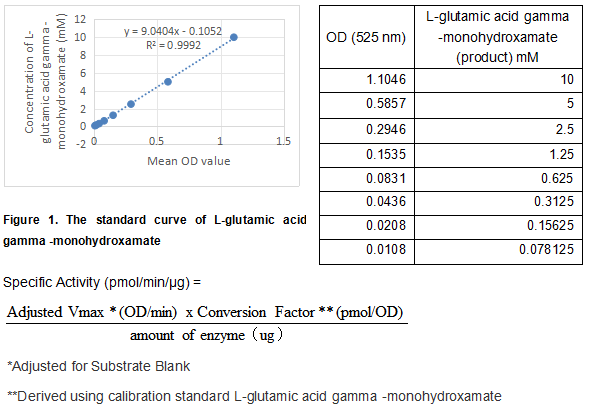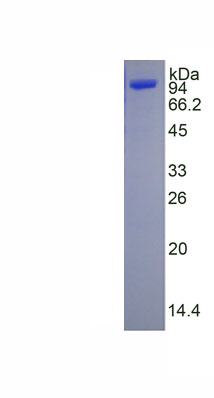Active Transglutaminase 2 (TGM2) 

tTG; TG2; C Polypeptide,Protein-Glutamine-Gamma-Glutamyltransferase; Transglutaminase 2, Tissue; Transglutaminase C; Transglutaminase H
Overview
Properties
- Product No.APB830Hu01
- Organism SpeciesHomo sapiens (Human) Same name, Different species.
- ApplicationsCell culture; Activity Assays.
Research use only - DownloadInstruction Manual
- CategoryInfection immunity
- Buffer FormulationPBS, pH7.4, containing 0.01% SKL, 5% Trehalose.
- Traits Freeze-dried powder, Purity > 95%
- Isoelectric Point4.8
Sign into your account
Share a new citation as an author
Upload your experimental result
Review

Contact us
Please fill in the blank.
Activity test

Transglutaminase 2 (TGM2), encoded by the TGM2 gene, is belongs to the family of transglutaminases that catalyze the posttranslational modification of proteins via calcium dependent cross-linking reactions. In addition to its function in protein cross-linking, TGM2 is also capable of hydrolyzing both GTP and ATP and has intrinsic kinase activity. TGM2 has been implicated in a variety of human diseases including celiac disease, inclusion body myositis, atherosclerosis, and neurodegenerative diseases. The activity of recombinant human TGM2 is measured by its ability to cleave a synthetic peptide Benzyloxycarbonyl-Gln-Gly and NH2OH in the assay buffer 200 mM MES, 10 mM DTT, 10 mM CaCl2, 100 mM Hydroxylamine Hydrochloride, pH 6.0. The rhTGM2 is diluted to 12.5 ug/ml in assay buffer. Loading into a clear well plate 50 µL of 12.5 ug/mL rhTGM2 and start the reaction by adding 50 µL of 100 mM substrate, with a substrate blank containing 50 µL assay buffer, 50 µL substrate, and no rhTGM2. Incubated at 37 °C for 2 hours and stop the reaction with 400 ul stop solution of 0.37 M FeCl3, 0.67 M HCl,0.2 M Trichloroacetic Acid. Centrifuge at 2000 rpm for 2 minutes and then load 200 ul of the supernatant into a plate and read at 525 nm (absorbance) in endpoint mode. The specific activity of recombinant human TGM2 is > 800 pmol/min/µg.
Usage
Reconstitute in 10mM PBS (pH7.4) to a concentration of 0.1-1.0 mg/mL. Do not vortex.
Storage
Avoid repeated freeze/thaw cycles. Store at 2-8°C for one month. Aliquot and store at -80°C for 12 months.
Stability
The thermal stability is described by the loss rate. The loss rate was determined by accelerated thermal degradation test, that is, incubate the protein at 37°C for 48h, and no obvious degradation and precipitation were observed. The loss rate is less than 5% within the expiration date under appropriate storage condition.
Increment services
-
 BCA Protein Quantification Kit
BCA Protein Quantification Kit
-
 Molecular Mass Marker for Protein
Molecular Mass Marker for Protein
-
 Monoclonal Antibody Customized Service
Monoclonal Antibody Customized Service
-
 Polyclonal Antibody Customized Service
Polyclonal Antibody Customized Service
-
 Protein Activity Test Experiment Service
Protein Activity Test Experiment Service
-
 Electrophoretic Mobility Shift Assay (EMSA) Experiment Service
Electrophoretic Mobility Shift Assay (EMSA) Experiment Service
-
 Buffer
Buffer
-
 Lentivirus Packaging Experiment Service
Lentivirus Packaging Experiment Service
-
 Adenovirus Packaging Experiment Service
Adenovirus Packaging Experiment Service
-
 Real Time PCR Experimental Service
Real Time PCR Experimental Service
-
 Spike RBD Protein (S-RBD)
Spike RBD Protein (S-RBD)
-
 Protein G
Protein G
-
 Protein A
Protein A
Citations
- Tissue transglutaminase is involved in mechanical load–induced osteogenic differentiation of human ligamentum flavum cellsPubmed:27115725
- ECM Crosslinking Enhances Fibroblast Growth and Protects Against Matrix Proteolysis in Lung Fibrosis.pubmed:29053339
- Metformin attenuates TGF‑β1‑induced pulmonary fibrosis through inhibition of transglutaminase 2 and subsequent TGF‑β pathwaysPubmed: 32550106







